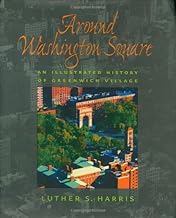Around Washington Square: An Illustrated History of Greenwich Village
Luther S. Harris
400 pages, Hardcover
ISBN: 080187341X
ISBN13:
Language: English
Publish: October 9, 2003
Describing Washington Square, Henry James wrote that it was “as if the wine of life had been poured for you, in advance, into some pleasant old punch bowl.” Created in 1826 through the visionary efforts of philanthropist and New York City mayor Philip Hone, the elegant and vibrant square anchors one of the world’s most storied neighborhoods, Greenwich Village. Today, the quarter retains much of the charm it possessed in earlier eras when it served as a mecca for artists and activists, intellectuals and indigents, brahmins and bohemians. Yet its history has been clouded by half-truths and myths, while some of its most colorful and influential residents―and its role in the city’s growth―lie undiscovered. Neighborhood historian and preservationist Luther S. Harris has spent twenty years researching the real story of New York’s social and cultural hub, and in Around Washington Square he has produced the definitive history of Greenwich Village, illustrated with more than two hundred photographs and engravings, many from his private collection. Harris’s prodigious research efforts among city council minutes, real-estate tax and conveyance ledgers, directories, family histories, architectural records, institutional and business inventories, newspapers, private collections, and public archives have uncovered surprising facts about the origins of Greenwich Village and its influence on the development of Fifth Avenue and upper Manhattan. Formally established as a separate political jurisdiction―the Fifteenth Ward―in 1832, the neighborhood known today as Greenwich Village reached its social apogee in the 1850s and 1860s as the home of New York’s wealthiest and most powerful citizens. Then known as the Empire Ward, it boasted Manhattan’s finest churches and homes, its most exclusive clubs, its best-endowed libraries and galleries, and its grandest hotels, shops, and theaters. The neighborhood had also begun to attract artists and writers, including leading members of the Hudson River School and such prominent literary talents as Edgar Allan Poe, Herman Melville, and Walt Whitman. Deftly balancing architectural, cultural, political, and social history, Harris follows the quarter’s history into the twentieth century. Early in the century the Village acquired its bohemian reputation and became synonymous with radical politics, revolutionary art, and idiosyncratic lifestyles. Intellectual exchanges at Mabel Dodge’s Fifth Avenue salon, among others, reverberated nationwide, as did the groundbreaking plays of Eugene O’Neill, journalism of Lincoln Steffens, and paintings of the Ashcan School. As expertly recounted by Harris, for the rest of the twentieth century the Village continued to draw many in the arts―from Edward Hopper and Jackson Pollock to Allen Ginsberg and Bob Dylan―helping to make New York the art capital of the world. Preservation battles in the 1950s and 1960s over the opposing ideas of Robert Moses and Jane Jacobs left the Village fabric largely intact. Concluding with the neighborhood’s decline in the 1970s and renaissance in the 1980s and 1990s, Around Washington Square captures the charm, energy, and individuality of Greenwich Village.
